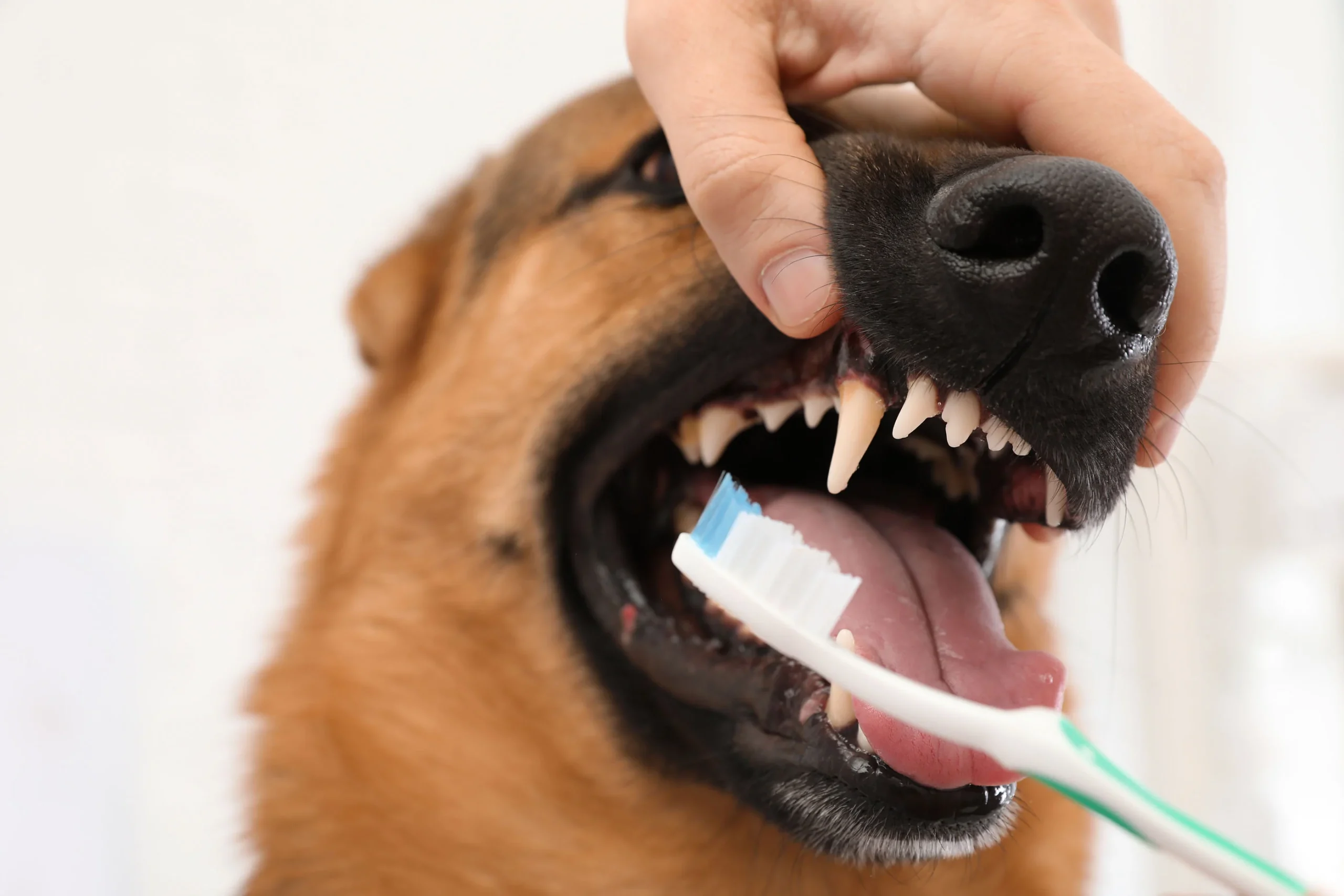Its estimated that, than 80% of dogs aged three and older suffer from disease, which is an inflammation or infection of the tissues surrounding their teeth.
Periodontal disease typically starts as gingivitis due to plaque buildup. Can progress to affect the tooth sockets bone structure. Plaque, an accumulation forms on teeth after eating or even after a professional dental cleaning. Within a day plaque mixes with saliva minerals to form tartar also called calculus.
If left untreated periodontal disease can result in tooth loss. Refer to the handout “Dental Disease in Dogs” for details on this condition.
When should I brush my dogs teeth?
Similar to us its recommended to brush your dogs teeth at daily. Once brushing becomes a part of their routine many dogs may come to anticipate and enjoy it. Brushing at three times per week is advised as a minimum to help eliminate plaque and prevent buildup.
It’s ideal to introduce your dog to tooth brushing while they’re still puppies. For dogs the training process might take longer. Is still beneficial, in the long run.
What steps should I take to help my dog get used to having its teeth brushed? To successfully brush your dogs teeth it’s important to ensure that both you and your dog have an experience. Make sure to praise your dog throughout the process and provide reassurance at each step. Here are some tips, for achieving the results;
1. Choose a time and place to start.
2. If your dog is small hold it securely in your lap with its head facing from you. For dogs sit on a chair with your dog sitting beside you so you can easily access its mouth and teeth.
3. Begin by rubbing your finger or a soft cloth over the surfaces of your dogs teeth in a back and forth motion focusing on where the gum meets the tooth surface. Stick to the surfaces of the teeth to avoid any bites. In sessions consider rubbing a few teeth instead of the entire mouth especially if your pet seems unsure or anxious about brushing.
4. Once your dog is comfortable, with having its teeth rubbed introduce an amount of toothpaste for it to taste from your finger.
Avoid using toothpaste, for humans as it is not meant to be swallowed. Once your furry friend gets accustomed to the taste of pet toothpaste gently apply an amount on a cloth. Rub it on their teeth. Once your dog is comfortable with you cleaning their teeth using a cloth it’s time to transition to using a toothbrush.
Wondering what kind of toothbrush would be best? There are commercial toothbrush options designed specifically for dogs, such as angled handles, brushes with heads for thorough cleaning, compact brushes that are easy to handle and finger toothbrushes that slide over your finger.
In some cases soft baby toothbrushes intended for use can also be suitable for certain dogs. The choice of toothbrush depends on your dogs size and your own ability. Many pet parents find finger brushes convenient especially when starting the teeth brushing routine. If you’re unsure, about the right brush to use consult your veterinarian.
No matter what kind of toothbrush you choose it’s important to be gentle and take your time while brushing. You want to avoid poking the toothbrush hard against your gums, which could lead to some irritation.
Can I use toothpaste for my pet?
No its not recommended. Human toothpastes have ingredients that’re not safe if swallowed by pets. They can cause stomach issues or digestive problems. Some human toothpastes contain levels of sodium that could make your pet sick and others might have xylitol, a sweetener that is toxic to dogs.
My friend suggested using baking soda for brushing my pets teeth. Is that okay?
No it’s not an idea. Baking soda is highly alkaline. Swallowing it can disrupt the stomachs acid balance. Additionally dogs may not like the taste of baking soda, which could make them uncooperative, during teeth brushing sessions.
Why do they recommend using toothpaste?
Pet toothpaste comes in flavors like poultry, beef, malt and mint that dogs find appealing. Using a product can make the teeth brushing experience more enjoyable, for your dog. You can find a list of products approved by the Veterinary Oral Health Council at vohc.org.
How should I brush my dogs teeth properly? Here are the steps to follow for a tooth brushing session.
Start by putting an amount of toothpaste on the toothbrush. Then gently lift one side of your dogs lips to access his mouth either by pushing up on the lip with your index finger or, by placing your hand over his head with your thumb and index finger, on sides of his jaw to raise his lips.
To reach the teeth you’ll need to open your dogs mouth. You can do this by tilting his head while holding onto his upper jaw with your thumb and index finger.
Begin by focusing on brushing the cheek teeth and canine teeth as these are where plaque and tartar build up quickly. Gradually progress to brushing all of the teeth, which may take a few days or even weeks.
Don’t worry much about brushing the tips or inner surfaces of the teeth unless your dog’s cooperative. The significant periodontal damage usually occurs on the surfaces of the teeth so thats where you should concentrate your efforts.When you brush your dogs teeth their tongue can help remove plaque from the tooth surfaces so you don’t have to brush those areas often.
How time should I dedicate to brushing my dogs teeth?
Its recommended to brush each side for 30 seconds.
Is there anything I should keep in mind?
Absolutely. Dogs have a lot of bacteria in their mouths. If possible wear gloves while brushing their teeth. If wearing gloves makes it hard to brush effectively make sure to wash your hands with soap and water. Also rinse the toothbrush before storing it. Replace the toothbrush every three months. Use an one for each of your dogs if you have more, than one.

